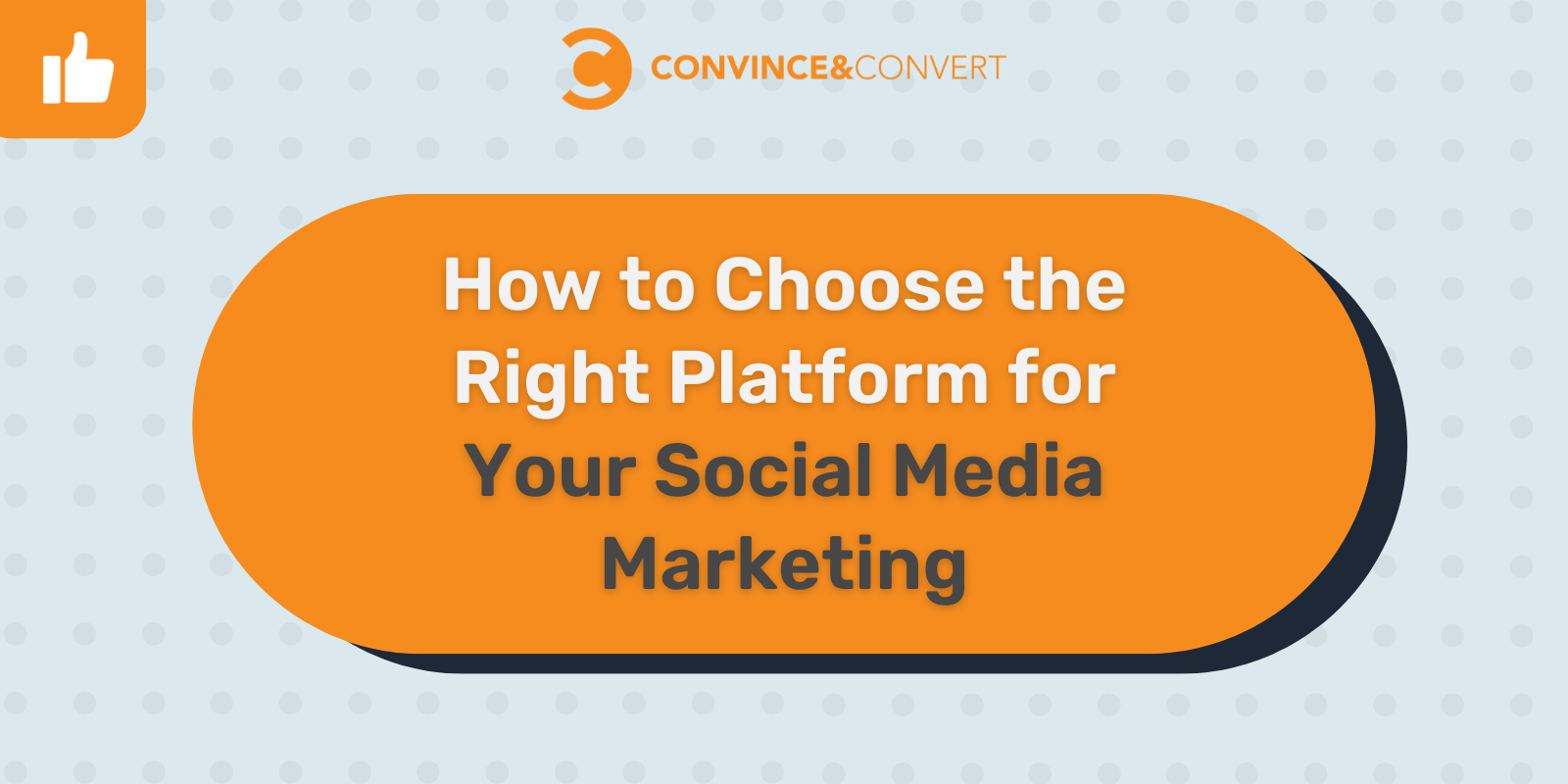
75% of internet users flock to social media to research products. That’s over two billion potential consumers.
And with over seventeen social media platforms available to reach your audience, you’ll want to be sure you’re everywhere they are. In the “good old days,” it might have been enough to create a Facebook page and think: “Hey – we’re on Facebook! We’re social!” Nowadays, people are using multiple platforms and expect you to be there too.
What’s more, each social media platform has its unique characteristics and strengths. Some are better suited for certain types of businesses than others. So how do you choose the right one? How do you know if Instagram, Facebook, or Twitter is right for you?
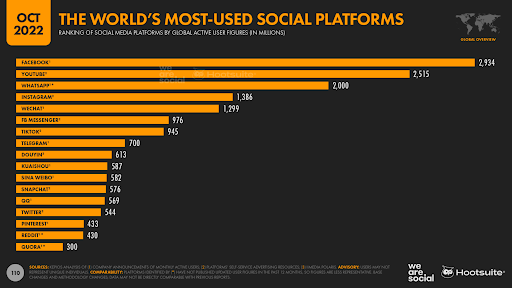
In this article, we’ll discuss the step-by-step process of how to choose the right social media platform:
Each Social Media Platform is Unique: A Quick Introduction
The social media landscape has changed dramatically over the past few years. The rise of mobile devices, the explosion of video and live streaming, and new technologies like artificial intelligence have profoundly impacted how people use social media.
Before we discuss the process of selecting the right social media platform, let’s take a look at some of the most popular ones.
Here are all the major social media platforms you can use:
- TikTok – TikTok is a short-form video app that you can use to create and share 15-second videos on any topic. It has over 1 billion active users worldwide and is used by several celebrities and brands.
- Instagram – Instagram is a free social media platform that lets users share photos and short videos. The post features are image sharing, reels, live streaming, private messaging, messaging, and “story.” Instagram Stories alone are used by 500 million users daily.
- Youtube – The service allows you to upload, view, rate, and share videos with your audience worldwide. Users can also comment on videos they like or dislike. The site gets over 14 billion visits every month, more than even Facebook, Wikipedia, Amazon, and Instagram.
- Facebook – Facebook is a social media platform that lets you share photos, text messages, videos, and post content. You can also use its Facebook Live feature to stream videos. As of 2021, it’s the world’s largest social media platform, with 2.85 billion monthly active users.
- LinkedIn – LinkedIn is an online business-oriented social networking service that operates via websites and mobile devices. It has over 830 million users in more than 200 countries and territories and you can connect to them with just a few mouse clicks.
The website is all about professional networking. One of its main features is its Cover Story, which allows you to create 20 seconds of personalized video and make an excellent first impression on your audience.
- Twitter – Twitter is for making connections, sharing resources, and tracking the latest news in your field. One of the best features is the ability to use hashtags and tag up to 10 accounts on a Tweet. There are 396.5 million monthly active users worldwide who use Twitter.
- Clubhouse (audio) – Clubhouse is a free, new social network app where people from all over the globe can come together to talk, listen and learn in real time. It has over 28 million downloads worldwide.
- Snapchat – Snapchat supports the short, temporary sharing of photos and videos. You can advertise with traditional ads, lenses (which add special effects to photos), geotags (toggled location settings), and branded filters (which add fun design elements). As of Q1 2022, it had 332 million daily active users worldwide.
- Pinterest – Pinterest allows you to share images that appeal to a wide range of people and target potential customers from the 443 monthly users. Users are very open to buying new products, so brands can present their products at the decision making stage.
- Reddit – Reddit is a great place for businesses to share helpful information about their products. A study found that 90% of Reddit users who use the site for research trust the product information they find there more than they trust information from other sites.
- Quora – Quora is a question-and-answer site that lets users ask questions and get answers from others. As of January 2020, it had 200 million unique monthly visitors and more than 150 million active users.
Whether you’re a designer, developer, writer, photographer, filmmaker, or something else, there’s probably an appropriate social media platform for you.
Let’s see how you can determine the best platform for your social media marketing strategy.
7 Steps to Choose the Right Social Media Platform for Social Media Marketing
1. Define Your Ideal Customer
The first step to social media marketing is to determine your target audience. In other words, you must understand who your ideal customer is and how they use social media.
One of the best ways to do this is by creating an ideal customer profile or a buyer persona — a fictional person who represents your ideal customer.
A buyer persona will help you better understand what motivates people to buy from you and how they respond to specific types of content on different platforms.
For example, if you’re a business selling baby strollers, then your ideal customer would be someone who is pregnant and expecting a child in the next year.
The more detailed your buyer persona is, the better equipped you’ll be to create content that resonates with them.
Here’s the formula for defining your ideal customer profile:
To begin, identify your best customers – the ones who will benefit most from your products and services and are ready to buy. These people will have both the need for what you’re offering and the budget to buy from you.
Finding the best customers for your product also involves identifying why they are great customers, what made them buy so quickly, and what traits about them and your product make them such a great fit. This can be done by asking questions in interviews and media monitoring.
For a better context, here’s an example of a real-life buyer persona for a local real estate firm that includes demographics, pain points, factors influencing buying decisions, and expectations from the product.
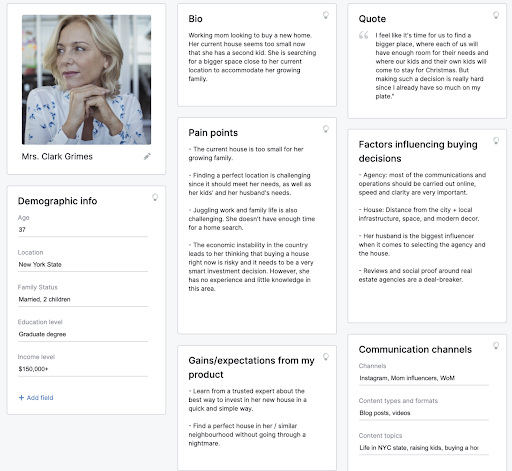
(Source)
The final step is to build a behavioral profile of your ideal customer. You can use the customer data provided by your CRM and information from your analytics tools.
When you know your buyer personas well, you can tailor your messaging to the needs of your target audience and the social media platform they’re most likely to be on.
For example, if you have a “young professional” persona, you might choose to advertise on Facebook or Instagram because it’s likely to reach a lot of young professionals there. But if you also have an “empty nester” persona, that same social media platform may not be the best fit for them – instead, consider advertising on LinkedIn or Twitter to reach that group.
2. Take a look at the demographics of the various platforms
The demographics of each platform are essential because they indicate who uses the platform and what their interests are. You’ll want to choose a platform where your target audience already exists and is active on that platform.
For example, if your target audience is primarily millennials or Gen Zers, then Instagram might be better for your business. If they’re older, Facebook might be more effective.
Here’s a quick overview of all the major social media platforms and their demographics:
TikTok (Predominantly young females):
- 41% of TikTok users are between 16-24 years old.
- Regarding gender demographics, 56.1% of TikTok’s users are female, and 43.9% are male Worldwide.
Instagram (Predominantly young well-to-do populace):
- As of 2022, most Instagram users are Millennial or Gen Z users. According to the Global State of Digital report, 8.5% are 13-17 years old, 30.1% are 18-24, and 31.5% are 25-34.
- As per Statista, only 44% of households who earn less than $30,000 yearly use Instagram, while 60% of households that earn more than $100,000 are more likely to use the app.
Facebook (Predominantly used by Millennials):
- According to the Pew Research Center report, of all the Facebook demographics, US users aged 65 or older grew the most, from 26% to nearly 40% between 2018 and 2019. Millennials and Baby Boomers only increased by 2%. And Generation X users decreased by 2%.
- In a study conducted in 2021, 84% of US Millennials are active Facebook users, making them the largest audience. 74% of US Gen X’ers reportedly use the platform.
YouTube (Predominantly used by Millennials and Gen Z)
- With about 225 million users, India contributes the most to YouTube’s viewership.
- Among US adults aged 18-29, 95% use YouTube, making millennials and Gen Z the largest groups of users.
LinkedIn (Predominantly used by middle-aged males):
- Statista, 2022 reports that 57.2% of LinkedIn users worldwide are male, while only 42.8% are female.
Twitter (Predominantly used by males):
- According to a study, in 2020, 52% of all tweets came from Gen-Z users.
- The most popular age group on Twitter worldwide is 25-34-year-olds.
- 56.4% of Twitter users are male, while 43.6% are female.
- 33% of Twitter users have a college-level education.
Clubhouse (Predominantly used by males):
- According to an Edison Research study, 15% of social media users aged 18+ reportedly have used Clubhouse.
- As per stats, 66% of users on the platform are male, 56% are 18-34-year-olds, 42% are aged 35-54, and 2% are 55 or more.
Snapchat (Predominantly used by young females):
- According to statistics, India has the largest Snapchat audience, with 115.95 million users as of July 2021, followed by the United States, with 106.2 million users, and France, with 24.1 million users.
- Regarding gender demographics, Females make up 54.4% of its users. 44.6% of the users on Snapchat are male.
- In the United States, 15-25-year-olds make up 48% of users, while 26-35-year-olds make up 30% of users.
Pinterest (Predominantly used by young, upper-middle-class females from the US):
- Studies show that 38% of Pinterest users are between 50 and 65.
- In the US, 31% of adults use the platform.
- More than 86 million Pinterest ad audience members live in the U.S., followed by Brazil at 27 million.
- There are nearly 21 million Gen Z users on Pinterest.
- Nearly 77% of users are women.
- 45% of people in the US who earn a household income of more than $100K are active on Pinterest.
Reddit (Predominantly used by males from the US with a college degree):
- As per studies, Reddit is the 7th most visited site in the US, with 49.69% of users from the country as of September 2020.
- In the US, 15% of Reddit users are male, while only 8% are female.
- 5% of Reddit users have a degree or college education.
Quora: (Predominantly used by young males with a college degree):
- Most Quora users belong to the age group of 18-24 and make up 45% of total users.
- Around 65% of Quora users have a college degree.
- Quora is used by 57% of males and 42% of females
- 35% of Quora users are based in the US.
- 54% of adult users on Quora have a household income of $100k.
Social networks like Facebook offer built-in tools to help you understand your audience better.
Take Facebook’s Audience Insights, for instance:
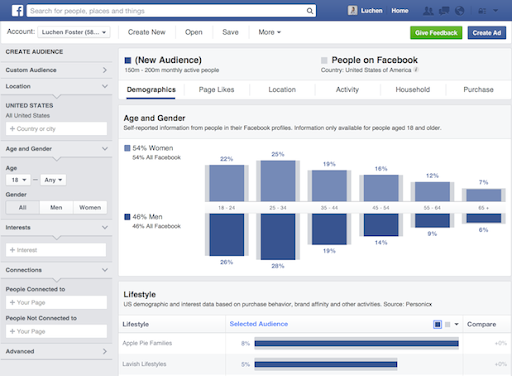 (Source)
(Source)
It’s easy to use and will give you a good idea of where your potential customers are coming from, their agen and gender, and what they are interested in.
3. Determine the brands that your target audience already follows
If you have an existing customer base and look at their favorite brands and influencers, you’ll be able to narrow down where they spend most of their time online. From there, you can look at what type of content they like to see and prioritize those platforms when creating new content for your marketing efforts.
If you’re interested in Instagram, for example, see which brands and individuals they follow. If you’re trying to reach people on Facebook and Twitter, look at their newsfeeds and search histories to see what types of content get liked and shared most frequently.
An excellent way to start the research process is by using social listening tools, which allow you to track what people are saying about your brand and its competitors (and even other companies that have nothing to do with your industry). This will help you determine which platforms will best suit your marketing efforts.
For example, let’s say you’re trying to decide between Facebook and Twitter for your business’s social media strategy. You could use a tool like Mention to track mentions of both Facebook and Twitter across multiple websites and blogs.
This also allows brands to jump into conversations and provide value before users move on from what they initially discussed.
For example, when Wendy’s made a play on Facebook’s brand update, Arby’s quickly joined in:
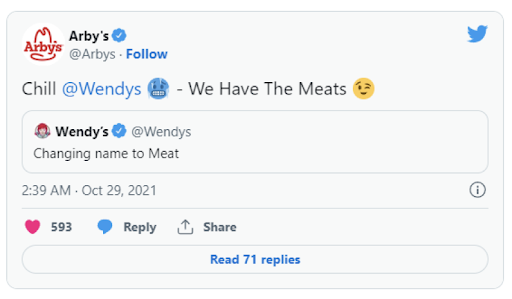
(Source)
These conversations will also help you discover what your audiences want and need, helping you create a solid social media marketing strategy.
4. Identify the places your competitors are active
If you’re looking for inspiration, look at what other businesses in your industry are doing on social media. See which platforms they’re using and whether there’s a pattern of activity on different sites. This will help you decide which platforms might be worth exploring further.
You can again find out where your competitor is active using social listening tools. These tools will give you a good idea about the demographics of their followers and help you identify which platform they are using.
Once you are privy to this information, you can also take inspiration from their content and even hack your competitor’s audience.
5. Choose a platform that suits your business type
Your social media platform should align with your brand and business goals. While there are many platforms out there, each one has its unique features and caters to different content types, so it’s crucial to think about which platform will work best for your business.
For example, Facebook is great for businesses with a large following and those who want to focus on building relationships. It’s also ideal for companies that want to reach customers through posts, ads, and other sponsored content.
If your business sells products or services that can be showcased visually, Instagram might be a good fit for you.
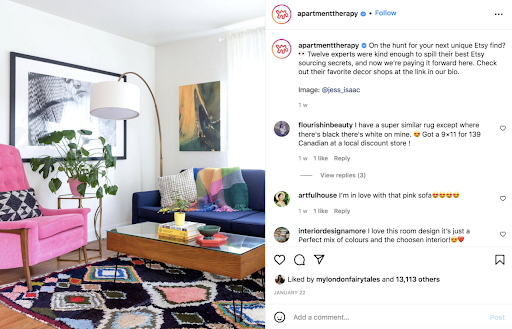
(Source)
One advantage here is that you can also leverage many third-party helper tools, automation tools and growth services to scale your Instagram Marketing.
If you’re looking for a place to post videos, then also Instagram is the OG social media platform.
It’s not like Facebook or Twitter, where you can only upload videos up to a certain length. With IGTV, you can post videos up to 60 minutes long. You can also add subtitles, captions, and other features that make your video more engaging for your audience.
For more video-centric content, however, YouTube is another great option.
For example, Amazon used YouTube Marketing to help potential customers better understand why they need the company’s products.
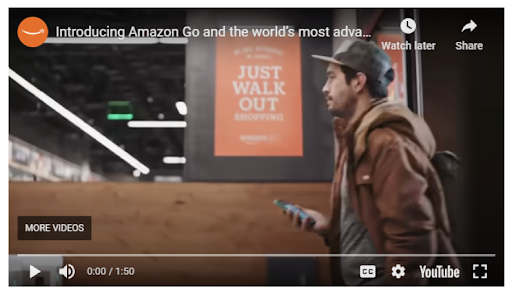
(Source)
They knew they had to reach their target audience uniquely. Text and images wouldn’t suffice, so they employed strategic e-commerce marketing techniques via YouTube.
If video marketing is your thing, then it’s also worth looking at more YouTube alternatives.
For many businesses, the big three social media platforms – Facebook, Instagram, and YouTube – are the only places they want to advertise on. But if you want to reach a younger audience and you don’t want to spend any money, then TikTok could be the place for you!
And while 60% of TikTok users are in the Gen Z age range, in recent months, the number of 25- to 34-year-olds has also increased from 22.4% to 27.4%. Clearly, TikTok is not just for teens and Generation Z. It can also be used to reach out to a more mature audience.
The best part? Since TikTok is a newer social media platform, the price of running ads can be much lower than Facebook and Instagram. For example, you can go viral on TikTok or reach 1,000 people for as low as 4 dollars!
For professional marketers there is now also the possibility to schedule Tik Tok posts up to 10 days in advance. And TikTok Ads also has many amazing features and advantages that other platforms don’t have.
For instance, you can run interactive ads that prompt users to click on a button or tap on an icon within the ad itself (instead of just watching it).
Check out how Adobe uses a clear CTA in their TikTok Ad below:
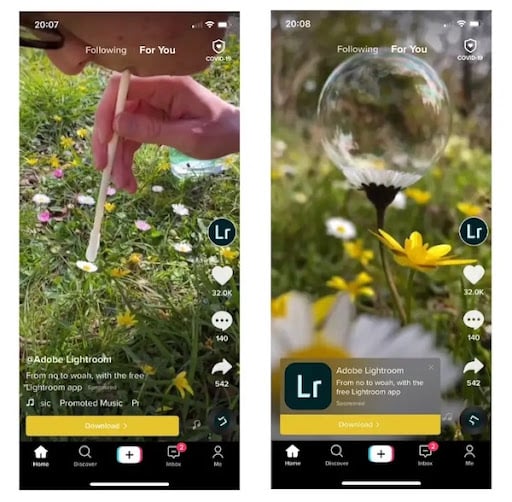
(Source)
On the other hand, Twitter is best suited for brands with strong personalities — think celebrities, comedians, or other entertainers — and businesses with newsworthy text-based content they want to share regularly with their followers.
If you have a service business like an accounting firm, LinkedIn is a good place for you to share articles about taxes or financial planning. However, if your brand is more visually appealing than it is informational, and if you are a large business, Instagram can still work for you.
Here are some suggestions by Buffer for specific products:
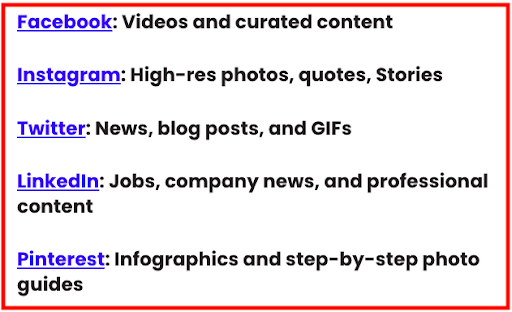
6. Consider your budget
Before diving headfirst into social media marketing, consider your budget and what it will take to get started. You’ll also want to consider how much time you have to manage different platforms.
For instance, on average, Instagram advertising can cost $0.20 to $6.70, depending on the bidding model. In comparison, research suggests that Facebook ads can cost you anything between $0.94 per click or $12.07 per 1,000 impressions.
Instead of paying for paid ads, it can also make sense to set up a strategy to work with influencers. Often, these campaigns are less expensive and have the character of authentic recommendations.
Also, always connect the expensive paid campaigns with your owned channels like email. With social media, you can get in touch with new potential customers and then nurture them via email.
7. Test, Measure, monitor, and reevaluate your decision
Once you’ve narrowed your choices, set up accounts on each platform and post some content. Then track the number of likes, comments, and shares for each post over a period of time. This will give you an idea of what kind of engagement rate each platform produces for your business.
You can also use an A/B test to determine what works best for your business. For instance, the Exploratorium discovered that replacing an image with a video increased their impressions on Facebook.

(Source)
Leverage the power of social media analytics tools to measure the performance of your activities and to reevaluate your decision.
The future of social media is always changing, and new networks are constantly emerging. You never know what might come of these networks – they might last for years or fizzle out in short order. If you’re looking at sites you’ve never heard of before, make sure to do your research before jumping in.
Who has the choice has the agony!
In closing, there is no single best platform for social media marketing, but deciding which to use will depend on your target audience, goals, products, budget, and more.
Whatever you choose, remember that social media is a relationship-based activity. Even the most astute content will only be worth a little if your interactions with other people are lacking. So remember to include social in your social media marketing strategy!
Author bio
Eduard Klein is an International Digital Growth Marketer, Blogger, and Entrepreneur with a global mindset. He guides through the process of starting and growing a digital business, and riding the wave of digital technology and marketing without getting swept away.


